THE ORIGIN OF "THE COTTONPICKERS"
by
Ruffin W. Gray, Colonel, USAF (Ret)
Commander, 15th TRS -- Oct. ‘51 - May ‘52
In June 1951, the 15th Tactical Reconnaissance Squadron (Photo Jet)
was flying off the hot, dusty PSP strip at K-2, Korea. When the North
Koreans invaded, the squadron had been the 8th Tactical Reconnaissance
Squadron (TRS) at Yokota, Japan and commanded by Lt. Col. Jake Dixon.
The 8th TRS began flying missions out of Itazuke the first day of
the invasion and had moved up and down the Korean peninsula as the
war progressed. The 8th has been officially credited with originating
the motto "Every Man A Tiger", and the motto was carried
over to the 15th TRS.
The 67th
Tactical Reconnaissance Wing (TRW) was subsequently formed, and the
8th TRS was re-designated as the 15th TRS. The other squadrons in
the wing were the 45th TRS with RF-51s and the 12th TRS with RB-26s.
The wing was commanded by the renowned Col. Karl "Pop" Polifka
who had gained well-deserved recognition in WW II as commander of
recon units in the SWPA, African and European theaters. Col. Dixon
was the 67th Tactical Reconnaissance Group commander at K-2 airfield
in Taegu.
The 15th TRS
was equipped with about 24 old RF-80s. The tail numbers all began
with "45" which gives you a
clue as to how old they were. The old engine put out about 3500 pounds
thrust which had to be augmented with a water/alcohol tank for take-off.
The birds were so old that they had a manual starting system, a manual
canopy, and a hard seat - no ejection, just climb over the side.
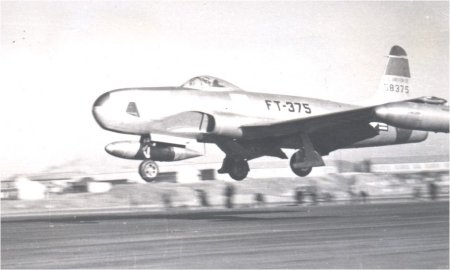
RF-80 Lands at Kimpo Airfield
In early June ‘51, two young junior captains reported to the
squadron on the same day - Capt. Harry Morris, an Air National Guard
(ANG) pilot from Birmingham who had volunteered for active duty to
do his part (Harry was one of the finest pilots and best officers
I have ever known. He volunteered for active duty, came to Korea,
flew his 100 missions, went home and reverted to ANG status).
I had spent
the last 11 months shuffling papers in the personnel shop of 13th
AF Headquarters at Clark Air Force Base in the Philippines, and volunteering
for every flying assignment in Korea that came through. On a TDY to
Korea, I told "Pop" Polifka my tale of woe, and he got me
released from 13th AF.
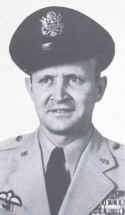
Major Clyde B. EastThe squadron was commanded by Major Clyde B. East
who had become an ace in the European Theater of Operations (ETO)
while flying RF-51’s in the Second World War. Clyde had so many
Air Medals that the Air Force had authorized him to wear two ribbons
since he couldn’t get all his clusters on one ribbon. He shot
down 11 aircraft and had been threatened with court martial if he
shot down another German while flying a recce mission.
Major Exum F. BullardHe had to wait to claim his last two victories
until the AF commander rotated to avoid court martial. Capt. Exum
F. Bullard was squadron Operations Officer.
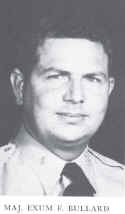
When Harry Morris and I joined the squadron, the pilots included some
of the original cadre from Japan and about half new replacements;
mostly young Lts. Lt. Bryce Poe had flown a tour with the 15th TRS,
and he ended up as a four-star and commander of Air Logistics Command.
Harry and I were surprised that the squadron was sorely lacking in
lots of amenities such as intelligence and briefing boards and no
pilot facilities - not even a coffeepot in Operations. We decided
to do something about it.
We quickly
learned that a T-33 ride over the front lines could open lots of supply
lines. After giving the Company Commander and Operations Officer of
a nearby Army Engineering Company a T-33 ride, we soon had a 6x6 unloading
a load of plywood and 2x4s at the squadron area.
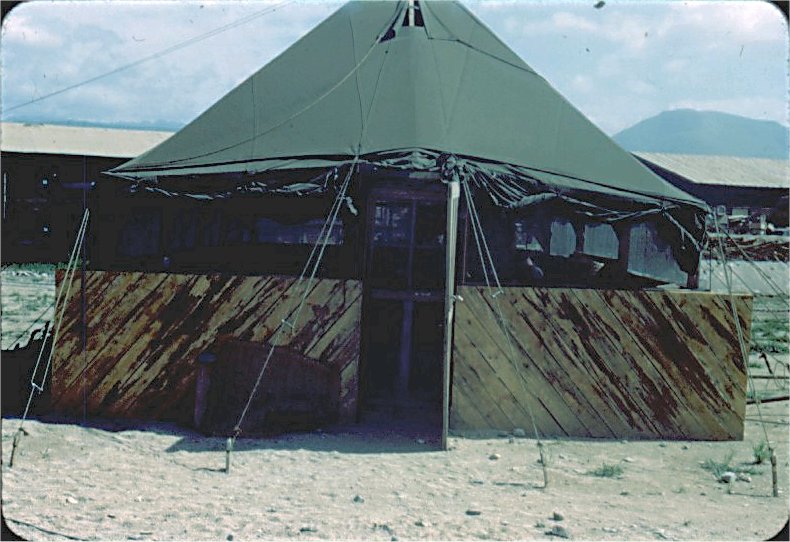
The Pilot's Lounge - Taegu
All the pilots
pitched in constructing a pilots lounge adjacent to operations. The
Photo Joes found out they could cut a double miter joint with a hand
saw to build a frame for a GI tent. With some parachute silk for the
ceiling, woven grass mats for wall covering, and other innovations,
the old CI tent took on a classy look. Squadron "Scroungers"
found ways to open up supply lines for beer and cokes, and we soon
had a pilots lounge equipped with dart boards, poker and card tables,
a bar and other amenities.
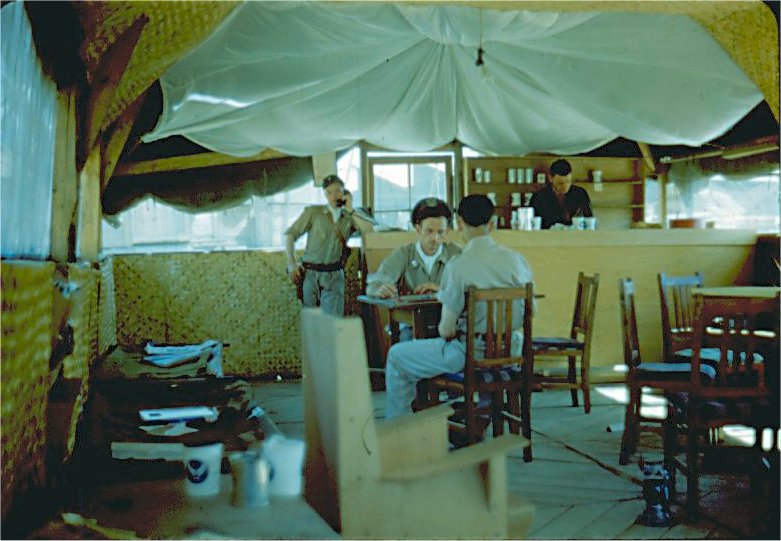
The 15th TRS pilot lounge soon became the orbit point for all pilot
activities - letter writing while waiting for missions, card and dart
games, reading, poker sessions, and sites for 100 missions parties,
birthdays, promotions, etc., etc. As activities increased, some club
rules emerged. Someone had turned up with an old fashioned, hard black
bowler hat - which became the symbol to identify the pilot serving
as bartender that night. It was also decreed that all pilots of the
flight scheduled for the next day?s early missions would leave the
club at 2200, and retire for the evening.
The flight
commander of "D" flight was a great guy from Augusta, Georgia
whos favorite expression in an aggravated southern drawl was, "Come
on, you Cottonpickers, lets go". For some unknown reason, Rich
had been tabbed with the nickname "Shaky Leader" - not used
in a derogatory manner. So every time Rich's flight was scheduled
for the early missions, he'd stand up in the club at 2200 and announce
in a loud voice, "Okay all you Cottonpickers, lets go".
At some point, the question arose on a name for the club and someone
suggested "Cottonpickers" and it stuck.
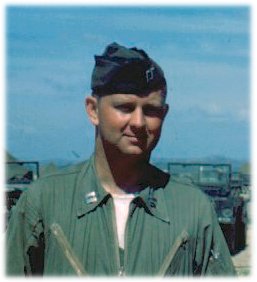
Captain Richard Stearns
In late August or early September 1951, the wing moved to Kimpo, K-14.
Clyde East and Exum Bullard rotated to the states, and Major Bruce
B. Fish became Major B.B. Fishsquadron commander and Captain Joe Daly
Operations Officer.
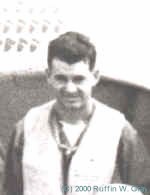
On arrival
at Kimpo, the squadron constructed another "Cottonpickers"
club - this time in two Jamesway huts immediately behind the Operations
Quonset hut.
Colonel Edwin
S. Chickering came over as Wing Commander with Colonel Bert Smiley
serving as his deputy. Colonel Charles C. Andrews arrived as Tactical
Group commander.
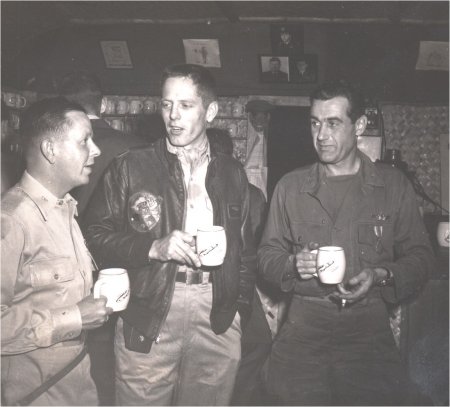
Col. Chickering, Maj. Gray and Col Andrews
We checked
Colonel "Chick" and "Andy" out in the RF-80, and
they became ardent supporters of the Cottonpickers club.
The 4th Fighter
Wing (the only F-86 equipped wing in Korea at that time) was on the
north side of Kimpo, and the 67th Wing occupied the south side along
with the Royal Australian Air Force (RAAF) squadron of Meteors, commanded
by Wing Commander Ron Susans. Ron later became an Air Commodore and
chief of the RAAF. The 15th Squadron and the Aussies soon became an
almost combined squadron, and the Aussies were in the Cottonpickers
club nightly.
Major Fish appointed me Squadron Exec; and after 30 days, I got a
spot promotion to Major. B. B. was then pulled up as Group Exec, and
I was designated Squadron Commander.
Lieutenant
General Frank Everest was 5th Air Force (FEAF) Commander who came
out to Kimpo from time to time. On his first visit, Colonel "Chick"
brought him down to the squadron and into the Cottonpickers for a
beer. Behind the bar, we had built mug racks to hold the squadron
beer mugs. At the top of the rack was a single slot with a big wheel
underneath and a mug inscribed "Hank" for Gen. Everest.
Underneath his mug were three slots with a smaller wheel and mugs
inscribed "Chick", "Bert", and "Andy"
for the wing CO, deputy and group Co. Underneath these three was a
slot with a little small wheel, and my mug "Ruff".
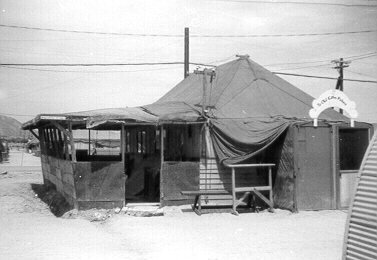
General Everest
immediately became a supporter of the Cottonpickers announcing that
it was the only bar in the world where he had his own mug. From then
on at the monthly 5th AF wing commanders conference, he would call
on Colonel Chickering first with the remark, "Well Chick, what’s
going on at the Cottonpickers?"
As time went on, squadron lounges such as the Cottonpickers sprang
up all over Korea. At one Wing Commanders conference, some bean counter
from the Comptroller shop announced that the squadron clubs would
have to be closed since they were generating a certain amount of money
without proper controls and accounting procedures. Gen. Everest stated
that such a decision, if carried out, would not apply to the Cottonpickers.
This is a
long-winded dissertation to explain the derivation of the name "Cottonpickers"
but it is the way it happened.
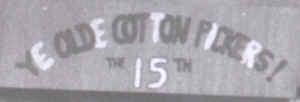
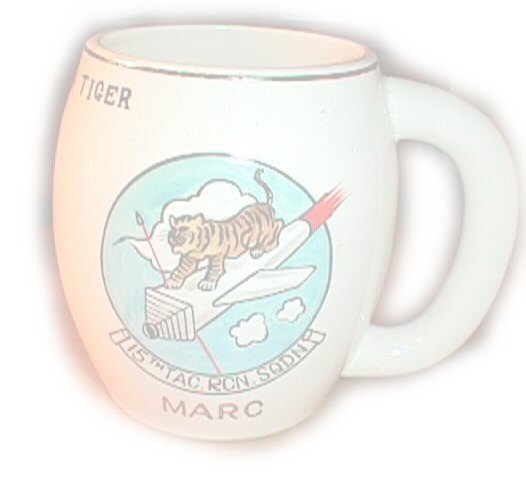
|